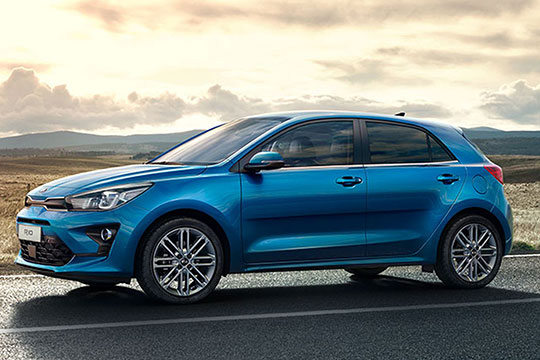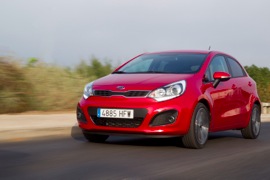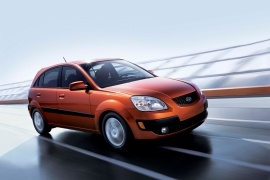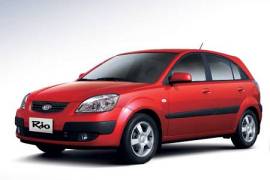KIA Rio Hatchback Models/Series Timeline, Specifications & Photos
First production year: 2005
Engines: Mild hybrid, Gasoline, Diesel
Body style: Hatchback
In late 2020, Kia introduced the facelifted version of the sub-compact range Rio. It brought a breath of fresh air to a car introduced in 2017.
The fourth generation of Rio was designed in Kia's design centers from Russelsheim (Germany) and California. It was no longer a car built for a low budget, but more of a car built to offer the most for its price. The 2021 version enhanced the visual elements and brought more technologies under the skin.
For the 2021 model, Kia designers introduced a massive grille in the lower part of the bumper, despite the small engines. The car's performances did not exactly match its aggressive look, but at least it was a more pleasant view when compared with the non-facelifted version. The angular headlights showed LED daytime running lights around the inner headlamps. The fog lights found their way into the side scoops, used as fake air-intakes to cool the disc brakes.
The interior showed more respect for the customers, and it helped the driver with a new infotainment unit offered as an option, with an 8" touch-screen placed on top of the center stack. The instrument cluster featured traditional, analog dials from its predecessor.
The powertrain was enhanced with a starter-generator that helped the car to comply and exceed the Euro 6d norms. The 1.2-liter and the 1.0-liter mild-hybrid engines were paired as standard with a manual transmission, while the latter unit was available with a 7-speed DCT (dual-clutch) automatic transmission.
The Kia Rio was the South Korean’s response to the VW Polo, Skoda Fabia and Vauxhall Corsa. The Rio was redesigned to grab the people’s attention and was a good deal for a car in its segment.
The exterior design doesn’t stand out, however, it was lower and with a sportier appearance than the last Kia’s Rio.
The back of the Rio was modified and looked more tight and compact.
Kia decided to drop the 3-door model and kept the 5-door, the Rio being a practical car and most suitable for families as a city car.
When opening the trunk lid, you could see a good sized load area that could even be extended by folding the rear seats. The load space was larger that the Corsa’s or the Polo’s.
The only downside of the trunk was its high position, thus heavy luggages were a bit hard to load.
A full grown up sitting in the rear seats of the Rio would enjoy even long trips, as both legroom and headroom were good.
In the back were little cupholders and no storage compartments, not even the pocket on the backs of the front seats.
The Rio was available with 3 trim levels, simply named 1, 2 and 3.
The 1 trim level offered air conditioning, heated mirrors, split-folding rear seats, the 2 came with electric windows, alloy wheels, a digital radio, USB, a reversing camera, cruise control and safety systems such as emergency braking and lane departure warning.
The top of the range, the 3 trim level was equipped with bigger alloys, heated seats with leather upholstery, sat-nav, smartphone connectivity and a rain sensor for the wipers.
Kia introduced the three-door version of the Rio's third generation in 2012, one year after it successfully launched the five-door model.
Kia was running the high tides when it launched the small-sized Rio. Its design department was led by Peter Schreyer and has proven to create attractive vehicles. Even though this small vehicle was penned by Sung Wook Kim, the signature design elements were already established. And they worked!
Sporting a similar front fascia as its five-door sibling, the three-door Rio featured swept-back headlights that flanked the tiger-nose main grille. In addition, to complete the slightly aggressive look of the car, the lower bumper featured an upside-down trapezoidal grille fitted with pair of scoops on the sides. From its profile, the three-door Rio showed its long doors and small side window for the rear-seated passengers. Finally, at the back, the raked-forward C-pillar and the tailgate offered a sporty image of this small-sized vehicle.
Inside, the automaker tried to create a spacious environment for five adults. While the front seats achieved that goal, there was hardly room for more than two adults in the back. On the plus side, Rio's dashboard offered a clear layout, with a binocular-styled instrument cluster that put the speedometer in the middle and the tachometer on the left. Kia placed the CD-Radio on the center stack on the upper side, followed by the HVAC control panel underneath it.
Under the hood, the Rio received the acclaimed 1.1-liter turbo-diesel that provided excellent fuel efficiency. In addition, Kia provided the car with another 1.4-liter turbo-diesel and two gasoline engines.
Kia introduced the fourth generation of the Rio lineup in 2011 at the Geneva Motor Show, and it was available as a sedan or a hatchback with either three or five doors.
Clearly, the Korean carmaker was on the right path. Moreover, it chose the right moment to introduce the new model since the world financial crisis was already gone, and the car market started to grow. Like its predecessor, the 2011 Rio was based on the same platform as the Hyundai Accent but aimed at different customers.
Its fresh look revealed the already-known "tiger-nose" signature grille imagined by Peter Schreyer, the man who changed the entire design language of the Korean automaker. The headlights were quite big and swept back on the sides of the vehicle. To complete the slightly aggressive stance of the car, the lower bumper featured an upside-down trapezoidal grille flanked by a pair of scoops. From its profile, the five-door Rio revealed its arched window line that resembled the one used on the Rio's third generation. Finally, at the back, the raked-forward C-pillar and the tailgate offered a youthful image for this small-sized vehicle.
Inside, the automaker tried to create a spacious environment for five adults. While the front seats achieved that goal, there was hardly room for more than two adults in the back. On the plus side, Rio's dashboard offered a clear layout, with a binocular-styled instrument cluster that put the speedometer in the middle and the tachometer on the left. Kia placed the CD-Radio on the center stack on the upper side, followed by the HVAC control panel underneath it.
Under the hood, the Rio received the acclaimed 1.1-liter turbo-diesel that provided excellent fuel efficiency. In addition, Kia provided the car with another 1.4-liter turbo-diesel and two gasoline engines.
In 2009, Kia introduced a facelifted version of its already known Rio subcompact vehicle. It was the right car at the right moment.
The 2008 world economic crisis hit hard in the automotive industry. On the other hand, Kia just stormed the market with the compact-sized cee'd hatchback and its seven-year warranty. Since most of the people wanted a reliable, trustworthy vehicle, the cee'd success was granted. In 2009, Kia introduced the facelifted version for the subcompact-sized range, the Rio.
The Rio's design was signed by the Italian institute I.DE.A., who was responsible for other success stories in the automotive industry. From the front, the Rio showed the same front fascia for the entire range. Its sharp, triangular, and curved headlights received clear lenses and a smoked interior. For the hatchback, the greenhouse line was ended abruptly behind the rear axle. The arched window line hid the thickness of the C-pillar. In the rear, the redesigned taillights featured a clear lens over the v-shaped reversing lights.
Inside, there were hardly any modifications to the dashboard. Apart from a new LCD digital clock on top of the center stack, it was hard to tell the difference. The interior space was the same, and up to five passengers were able to fit inside, but with limited room for the rear ones. Like on any hatchback, the rear bench seatback was folding.
Under the hood, Kia installed the same engines but updated in terms of European pollution regulations.
Kia grew in the U.S. market with the introduction of the first generation Kia Rio in 2000. While it was a low-cost car, it managed to offer great reliability for an attractive price.
In 2006, Kia raised the bar with the Kia Rio hatchback and even got the “Most Improved New Vehicle for 2006” awarded by Autobytel.
Why? Because the new Kia Rio offered class-leading power and interior room, as well as enhanced safety with six standard airbags, including full-length side-curtain airbags.
The improved interior volume was achieved with the longer wheelbase and the width and height increase.
Aesthetically, the small Rio had an European exterior design that inspired sportiness with a bold appearance.
Inside, the new Rio was fitted with improved quality materials. Besides the cloth upholstery that incorporated a sporty-looking mesh fabric, the cabin was fitted with an 8-way adjustable driver’s seat and a central armrest to enhance comfort.
The numerous storage space available inside the cabin added to the practicality of the Rio, as well as the dual 12V power outlets and a shopping bag hook placed on the back of the front passenger seat.
The new Kia Rio hatchback offered more standard power than any vehicles in its class, with the new 1.6-liter DOHC engine that produced 110 hp and 107 lb.-ft of torque. Fuel consumption was also improved by 20%.
For 2006, the hatchback in the SX trim level offered air conditioning, 15-inch alloy wheels, power steering with tilt, fog lights, a rear spoiler, a leather-wrapped steering wheel, metal grain interior trim and metal pedals.





